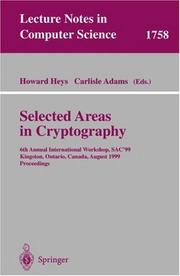| Listing 1 - 10 of 13 | << page >> |
Sort by
|
Book
ISBN: 3030810437 3030810429 Year: 2021 Publisher: Cham, Switzerland : Springer,
Abstract | Keywords | Export | Availability | Bookmark
 Loading...
Loading...Choose an application
- Reference Manager
- EndNote
- RefWorks (Direct export to RefWorks)
Data protection --- Cryptography. --- Data encryption (Computer science) --- Law and legislation. --- Data encoding (Computer science) --- Encryption of data (Computer science) --- Computer security --- Cryptography --- Cryptanalysis --- Cryptology --- Secret writing --- Steganography --- Signs and symbols --- Symbolism --- Writing --- Ciphers --- Habeas data --- Privacy, Right of
Multi
ISBN: 9783030810436 9783030810443 9783030810429 Year: 2021 Publisher: Cham Springer International Publishing
Abstract | Keywords | Export | Availability | Bookmark
 Loading...
Loading...Choose an application
- Reference Manager
- EndNote
- RefWorks (Direct export to RefWorks)
This textbook provides a unique lens through which the myriad of existing Privacy Enhancing Technologies (PETs) can be easily comprehended and appreciated. It answers key privacy-centered questions with clear and detailed explanations. Why is privacy important? How and why is your privacy being eroded and what risks can this pose for you? What are some tools for protecting your privacy in online environments? How can these tools be understood, compared, and evaluated? What steps can you take to gain more control over your personal data? This book addresses the above questions by focusing on three fundamental elements: It introduces a simple classification of PETs that allows their similarities and differences to be highlighted and analyzed; It describes several specific PETs in each class, including both foundational technologies and important recent additions to the field; It explains how to use this classification to determine which privacy goals are actually achievable in a given real-world environment. Once the goals are known, this allows the most appropriate PETs to be selected in order to add the desired privacy protection to the target environment. To illustrate, the book examines the use of PETs in conjunction with various security technologies, with the legal infrastructure, and with communication and computing technologies such as Software Defined Networking (SDN) and Machine Learning (ML). Designed as an introductory textbook on PETs, this book is essential reading for graduate-level students in computer science and related fields, prospective PETs researchers, privacy advocates, and anyone interested in technologies to protect privacy in online environments.
Human rights --- Programming --- Computer architecture. Operating systems --- Computer. Automation --- veiligheid (technologie) --- cryptografie --- informatica --- privacy --- netwerken (informatica) --- computerbeveiliging --- mobiele communicatie

ISBN: 157870166X 9781578701667 Year: 1999 Publisher: Indianapolis (Ind.): Macmillan
Abstract | Keywords | Export | Availability | Bookmark
 Loading...
Loading...Choose an application
- Reference Manager
- EndNote
- RefWorks (Direct export to RefWorks)
Computer security. --- Computer networks --- Business enterprises --- Sécurité informatique --- Réseaux d'ordinateurs --- Security measures. --- Sécurité --- Mesures --- Public key infrastructure (Computer security) --- Security measures --- -Computer networks --- -Public key infrastructure (Computer security) --- AA / International- internationaal --- 654 --- Infrastructure, Public key (Computer security) --- PKI (Computer security) --- Trust hierarchy (Computer security) --- Computer security --- Communication systems, Computer --- Computer communication systems --- Data networks, Computer --- ECNs (Electronic communication networks) --- Electronic communication networks --- Networks, Computer --- Teleprocessing networks --- Data transmission systems --- Digital communications --- Electronic systems --- Information networks --- Telecommunication --- Cyberinfrastructure --- Electronic data processing --- Network computers --- Business organizations --- Businesses --- Companies --- Enterprises --- Firms --- Organizations, Business --- Business --- -Security measures --- Informatieverwerking. Bureautica. --- Distributed processing --- Entreprises --- Sécurité informatique --- Réseaux d'ordinateurs --- Sécurité --- Computer network security --- Network security, Computer --- Security of computer networks --- Computer networks&delete& --- Informatieverwerking. Bureautica --- Computer networks - Security measures --- Business enterprises - Computer networks - Security measures
Book
ISBN: 3319725653 3319725645 Year: 2018 Publisher: Cham : Springer International Publishing : Imprint: Springer,
Abstract | Keywords | Export | Availability | Bookmark
 Loading...
Loading...Choose an application
- Reference Manager
- EndNote
- RefWorks (Direct export to RefWorks)
This book contains revised selected papers from the 24th International Conference on Selected Areas in Cryptography, SAC 2017, held in Ottawa, ON, Canada in August 2017. The 23 full papers presented in this volume were carefully reviewed and selected from 66 submissions. The focus of the conference was on specific themes in the area of cryptographic system design and analysis such as: Design and analysis of symmetric key cryptosystems Primitives for symmetric key cryptography, including block and stream ciphers, hash functions, and MAC algorithms Efficient implementations of symmetric and public key algorithms.
Computer science. --- Software engineering. --- Data encryption (Computer science). --- Artificial intelligence. --- Computer Science. --- Data Encryption. --- Artificial Intelligence (incl. Robotics). --- Software Engineering/Programming and Operating Systems. --- Data encoding (Computer science) --- Encryption of data (Computer science) --- Computer software engineering --- AI (Artificial intelligence) --- Artificial thinking --- Electronic brains --- Intellectronics --- Intelligence, Artificial --- Intelligent machines --- Machine intelligence --- Thinking, Artificial --- Informatics --- Computer security --- Cryptography --- Engineering --- Bionics --- Cognitive science --- Digital computer simulation --- Electronic data processing --- Logic machines --- Machine theory --- Self-organizing systems --- Simulation methods --- Fifth generation computers --- Neural computers --- Science --- Cryptology. --- Artificial Intelligence. --- Data encryption (Computer science)

ISBN: 9780672323911 0672323915 Year: 2003 Publisher: Boston, Mass.: Addison-Wesley,
Abstract | Keywords | Export | Availability | Bookmark
 Loading...
Loading...Choose an application
- Reference Manager
- EndNote
- RefWorks (Direct export to RefWorks)
Book
ISBN: 9783030810436 9783030810443 9783030810429 Year: 2021 Publisher: Cham Springer International Publishing :Imprint: Springer
Abstract | Keywords | Export | Availability | Bookmark
 Loading...
Loading...Choose an application
- Reference Manager
- EndNote
- RefWorks (Direct export to RefWorks)
1. The Privacy Minefield -- 2. A Collection of Tools: The Privacy Tree -- 3. Limiting Exposure by Hiding -- 4. Limiting Exposure by Hiding the Action -- 5. Limiting Exposure by Hiding the Identity-Action Pair -- 6. Limiting Disclosure by Hiding the Identity -- 7. Limiting Disclosure by Hiding the Attribute -- 8. Limiting Disclosure by Hiding the Identity-Attribute Pair -- 9. Using the Privacy Tree in Practice -- 10. The Path Forward -- Supplemental Chapters -- 11. Crypto Primer -- 12. Source Material -- Glossary -- Index. This textbook provides a unique lens through which the myriad of existing Privacy Enhancing Technologies (PETs) can be easily comprehended and appreciated. It answers key privacy-centered questions with clear and detailed explanations. Why is privacy important? How and why is your privacy being eroded and what risks can this pose for you? What are some tools for protecting your privacy in online environments? How can these tools be understood, compared, and evaluated? What steps can you take to gain more control over your personal data? This book addresses the above questions by focusing on three fundamental elements: It introduces a simple classification of PETs that allows their similarities and differences to be highlighted and analyzed; It describes several specific PETs in each class, including both foundational technologies and important recent additions to the field; It explains how to use this classification to determine which privacy goals are actually achievable in a given real-world environment. Once the goals are known, this allows the most appropriate PETs to be selected in order to add the desired privacy protection to the target environment. To illustrate, the book examines the use of PETs in conjunction with various security technologies, with the legal infrastructure, and with communication and computing technologies such as Software Defined Networking (SDN) and Machine Learning (ML). Designed as an introductory textbook on PETs, this book is essential reading for graduate-level students in computer science and related fields, prospective PETs researchers, privacy advocates, and anyone interested in technologies to protect privacy in online environments.
Human rights --- Programming --- Computer architecture. Operating systems --- Computer. Automation --- veiligheid (technologie) --- cryptografie --- informatica --- privacy --- netwerken (informatica) --- computerbeveiliging --- mobiele communicatie --- Computer networks. --- Computer security. --- Data encryption (Computer science).
Book
ISBN: 9783540773597 3540773592 3540773606 Year: 2007 Publisher: Berlin ; Heidelberg : Springer-Verlag,
Abstract | Keywords | Export | Availability | Bookmark
 Loading...
Loading...Choose an application
- Reference Manager
- EndNote
- RefWorks (Direct export to RefWorks)
SAC 2007 was the 14th in a series of annual workshops on Selected Areas in Cryptography. This is the ?rst time this workshop was held at the University of Ottawa. Previous workshops were held at Queen’s University in Kingston (1994, 1996, 1998, 1999, and 2005), Carleton University in Ottawa (1995, 1997, and 2003), University of Waterloo (2000 and 2004), Fields Institute in Toronto (2001), Memorial University of Newfoundland in St. Johns (2002), and Conc- dia University in Montreal (2006). The intent of the workshop is to provide a stimulating atmosphere where researchersin cryptology can present and discuss new work on selected areas of current interest. The themes for SAC 2007 were: – Design and analysis of symmetric key cryptosystems – Primitives for symmetric key cryptography, including block and stream ciphers, hash functions, and MAC algorithms – E?cient implementations of symmetric and public key algorithms – Innovative cryptographic defenses against malicious software A total of 73 papers were submitted to SAC 2007. Of these, one was wi- drawn by the authors, and 25 were accepted by the Program Committee for presentation at the workshop. In addition to these presentations, we were for- nate to have two invited speakers: – Dan Bernstein: “Edwards Coordinates for Elliptic Curves” – MotiYung:“CryptographyandVirologyInter-Relationships. ”Thistalkwas designated the Sta?ord Tavares Lecture. We are grateful to the Program Committee and the many external reviewers for their hard work and expertise in selecting the program.
Cryptography --- Computer security --- Cryptographie --- Sécurité informatique --- Congresses. --- Congrès --- Computer Science --- Engineering & Applied Sciences --- Computer science. --- Computer communication systems. --- Computer security. --- Data encryption (Computer science). --- Algorithms. --- Management information systems. --- Computer Science. --- Data Encryption. --- Systems and Data Security. --- Management of Computing and Information Systems. --- Algorithm Analysis and Problem Complexity. --- Computer Communication Networks. --- Information Systems Applications (incl. Internet). --- Computer-based information systems --- EIS (Information systems) --- Executive information systems --- MIS (Information systems) --- Sociotechnical systems --- Information resources management --- Management --- Algorism --- Algebra --- Arithmetic --- Data encoding (Computer science) --- Encryption of data (Computer science) --- Computer privacy --- Computer system security --- Computer systems --- Computers --- Cyber security --- Cybersecurity --- Electronic digital computers --- Protection of computer systems --- Security of computer systems --- Data protection --- Security systems --- Hacking --- Communication systems, Computer --- Computer communication systems --- Data networks, Computer --- ECNs (Electronic communication networks) --- Electronic communication networks --- Networks, Computer --- Teleprocessing networks --- Data transmission systems --- Digital communications --- Electronic systems --- Information networks --- Telecommunication --- Cyberinfrastructure --- Electronic data processing --- Network computers --- Informatics --- Science --- Communication systems --- Foundations --- Protection --- Security measures --- Distributed processing --- Information Systems. --- Computer software. --- Cryptology. --- Software, Computer --- Application software. --- Application computer programs --- Application computer software --- Applications software --- Apps (Computer software) --- Computer software

ISBN: 3540465138 3540671854 Year: 2000 Publisher: Berlin, Heidelberg : Springer Berlin Heidelberg : Imprint: Springer,
Abstract | Keywords | Export | Availability | Bookmark
 Loading...
Loading...Choose an application
- Reference Manager
- EndNote
- RefWorks (Direct export to RefWorks)
Computer security --- Data encryption (Computer science) --- Computer Science --- Engineering & Applied Sciences --- Computer security. --- Data encoding (Computer science) --- Encryption of data (Computer science) --- Computer privacy --- Computer system security --- Computer systems --- Computers --- Cyber security --- Cybersecurity --- Electronic digital computers --- Security of computer systems --- Security measures --- Protection of computer systems --- Protection --- Computer science. --- Computer communication systems. --- Data encryption (Computer science). --- Coding theory. --- Algorithms. --- Management information systems. --- Computer Science. --- Data Encryption. --- Coding and Information Theory. --- Computer Science, general. --- Computer Communication Networks. --- Algorithm Analysis and Problem Complexity. --- Management of Computing and Information Systems. --- Computer-based information systems --- EIS (Information systems) --- Executive information systems --- MIS (Information systems) --- Sociotechnical systems --- Information resources management --- Management --- Algorism --- Algebra --- Arithmetic --- Data compression (Telecommunication) --- Digital electronics --- Information theory --- Machine theory --- Signal theory (Telecommunication) --- Computer programming --- Cryptography --- Communication systems, Computer --- Computer communication systems --- Data networks, Computer --- ECNs (Electronic communication networks) --- Electronic communication networks --- Networks, Computer --- Teleprocessing networks --- Data transmission systems --- Digital communications --- Electronic systems --- Information networks --- Telecommunication --- Cyberinfrastructure --- Electronic data processing --- Network computers --- Informatics --- Science --- Communication systems --- Foundations --- Distributed processing --- Data protection --- Security systems --- Hacking --- Computer software. --- Information Systems. --- Cryptology. --- Software, Computer --- Information theory. --- Communication theory --- Communication --- Cybernetics
Digital
ISBN: 9783540773603 Year: 2007 Publisher: Berlin, Heidelberg Springer-Verlag Berlin Heidelberg
Abstract | Keywords | Export | Availability | Bookmark
 Loading...
Loading...Choose an application
- Reference Manager
- EndNote
- RefWorks (Direct export to RefWorks)
Complex analysis --- Computer science --- Computer architecture. Operating systems --- Information systems --- Computer. Automation --- ICT (informatie- en communicatietechnieken) --- DES (data encryption standard) --- cryptografie --- complexe analyse (wiskunde) --- informatica --- informatiesystemen --- computerbeveiliging --- informatica management --- computernetwerken
Book
ISBN: 9783540773603 Year: 2007 Publisher: Berlin, Heidelberg Springer-Verlag Berlin Heidelberg
Abstract | Keywords | Export | Availability | Bookmark
 Loading...
Loading...Choose an application
- Reference Manager
- EndNote
- RefWorks (Direct export to RefWorks)
SAC 2007 was the 14th in a series of annual workshops on Selected Areas in Cryptography. This is the ?rst time this workshop was held at the University of Ottawa. Previous workshops were held at Queen's University in Kingston (1994, 1996, 1998, 1999, and 2005), Carleton University in Ottawa (1995, 1997, and 2003), University of Waterloo (2000 and 2004), Fields Institute in Toronto (2001), Memorial University of Newfoundland in St. Johns (2002), and Conc- dia University in Montreal (2006). The intent of the workshop is to provide a stimulating atmosphere where researchersin cryptology can present and discuss new work on selected areas of current interest. The themes for SAC 2007 were: - Design and analysis of symmetric key cryptosystems - Primitives for symmetric key cryptography, including block and stream ciphers, hash functions, and MAC algorithms - E?cient implementations of symmetric and public key algorithms - Innovative cryptographic defenses against malicious software A total of 73 papers were submitted to SAC 2007. Of these, one was wi- drawn by the authors, and 25 were accepted by the Program Committee for presentation at the workshop. In addition to these presentations, we were for- nate to have two invited speakers: - Dan Bernstein: Edwards Coordinates for Elliptic Curves - MotiYung:CryptographyandVirologyInter-Relationships. Thistalkwas designated the Sta?ord Tavares Lecture. We are grateful to the Program Committee and the many external reviewers for their hard work and expertise in selecting the program.
Complex analysis --- Computer science --- Computer architecture. Operating systems --- Information systems --- Computer. Automation --- ICT (informatie- en communicatietechnieken) --- DES (data encryption standard) --- cryptografie --- complexe analyse (wiskunde) --- informatica --- informatiesystemen --- computerbeveiliging --- informatica management --- computernetwerken
| Listing 1 - 10 of 13 | << page >> |
Sort by
|

 Search
Search Feedback
Feedback About UniCat
About UniCat  Help
Help News
News